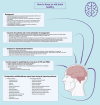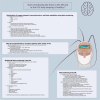Brain health: A concern for anaesthesiologists and intensivists
- PMID: 39917635
- PMCID: PMC11798402
- DOI: 10.1097/EA9.0000000000000063
Brain health: A concern for anaesthesiologists and intensivists
Abstract
Damage to the brain can have disastrous and long-lasting consequences. The European Society of Anaesthesiology and Intensive Care (ESAIC) is aware of the importance of taking good care of the brain, both of patients and of anaesthesia and intensive care unit (ICU) caregivers, and has organised a complete learning track on brain health to bring this concern to the attention of practitioners. This learning track included an online Focus Meeting on Brain Health (November 25, 2023). We here provide readers with a digest of the information that was delivered during that meeting in an opinion paper driven by the authors' own reading of the literature. It is divided according to the meeting's sessions, including how to improve the health of an injured brain, how to keep a young or old brain healthy, how to keep a healthy adult brain unimpaired, how monitoring can impact brain health in the operating room and in the intensive care unit, and how to keep the anaesthesia and ICU caregivers' brain healthy. Each part is a brief and focused summary. The main delivered messages are that the management of injured brain patients involves an adequate choice of sedation, adequate brain monitoring, and focused attention to specific points depending on the underlying pathology; that several measures can be undertaken to protect the brain of the very young needing anaesthesia; that it is possible to detect older patients at risk of postoperative neurocognitive disorders, and that dedicated perioperative management by a multidisciplinary expert team may improve their outcomes; that apparently healthy adult brains may suffer during anaesthesia; that the electroencephalogram may track peri-operative brain dysfunction, and that female patients should be given special care in this respect; that multimodal brain monitoring helps to detect pathological processes and to maintain brain homeostasis; and that burnout in anaesthesiologists can be effectively fought using personal, organisational, managerial and legal approaches.
Copyright © 2024 The Author(s). Published by Wolters Kluwer Health, Inc. on behalf of the European Society of Anaesthesiology and Intensive Care.
Conflict of interest statement
Conflicts of interest: VB has had or continue to have financial relationships with Medtronic, Edwards Medical, Orion Pharma, Grünenthal and Elsevier. He is Deputy Editor-in-Chief of the Acta Anaesthesiologica Belgica. BWB is treasurer of the European Resuscitation Council (ERC), Founder of the ERC Research NET, Chairman of the German Resuscitation Council (GRC), Member of the Advanced Life Support (ALS) Task Force of the International Liaison Committee on Resuscitation (ILCOR), Former Member of the Executive Committee of the German Interdisciplinary Association for Intensive Care and Emergency Medicine (DIVI), Founder of the ‘Deutsche Stiftung Wiederbelebung’, Federal Medical Advisor of the German Red Cross (DRK), Member of the Advisory Board of the ‘Deutsche Herzstiftung’, Co-Editor of ‘Resuscitation’, Editor of the Journal ‘Notfall + Rettungsmedizin’, Co-Editor of the Brazilian Journal of Anesthesiology. He received fees for lectures from the following companies: Forum für medizinische Fortbildung (FomF), ZOLL Medical Deutschland GmbH, C.R. Bard GmbH and Becton Dickinson GmbH. CR received fees as speaker from Edwards and BT. JCDG is an Editor for European Journal of Anaesthesiology. FAL is advisor for Masimo, Editor-in-Chief of the Journal of Clinical Monitoring and Computing, and EuroSIVA Chairman. AR has been a consultant for Medtronic and Neuroindex and has given a webinar for MSD.
Figures







References
-
- Le Roux P, Menon DK, Citerio G, et al. . Consensus summary statement of the International Multidisciplinary Consensus Conference on Multimodality Monitoring in Neurocritical Care: a statement for healthcare professionals from the Neurocritical Care Society and the European Society of Intensive. Neurocrit Care 2014; 21: (Suppl 2): S1–26. - PMC - PubMed
-
- Panchal AR, Bartos JA, Cabañas JG, et al. . Adult Basic and Advanced Life Support Writing Group Part 3: Adult Basic and Advanced Life Support: 2020 American Heart Association Guidelines for cardiopulmonary resuscitation and emergency cardiovascular care. Circulation 2020; 142:S366–S468. - PubMed
-
- Rajagopalan S, Sarwal A. Neuromonitoring in critically ill patients. Crit Care Med 2023; 51:525–542. - PubMed
-
- Cattalani A, Grasso VM, Vitali M, et al. . Transcranial color-coded duplex sonography for evaluation of midline-shift after chronic-subdural hematoma evacuation (TEMASE): a prospective study. Clin Neurol Neurosurg 2017; 162:101–107. - PubMed
-
- Brunser A, Hoppe A, Cárcamo DA, et al. . Validation of transcranial Doppler in the diagnosis of brain death. Revista medica de Chile 2010; 138:406–412. - PubMed
Publication types
Grants and funding
LinkOut - more resources
Full Text Sources
